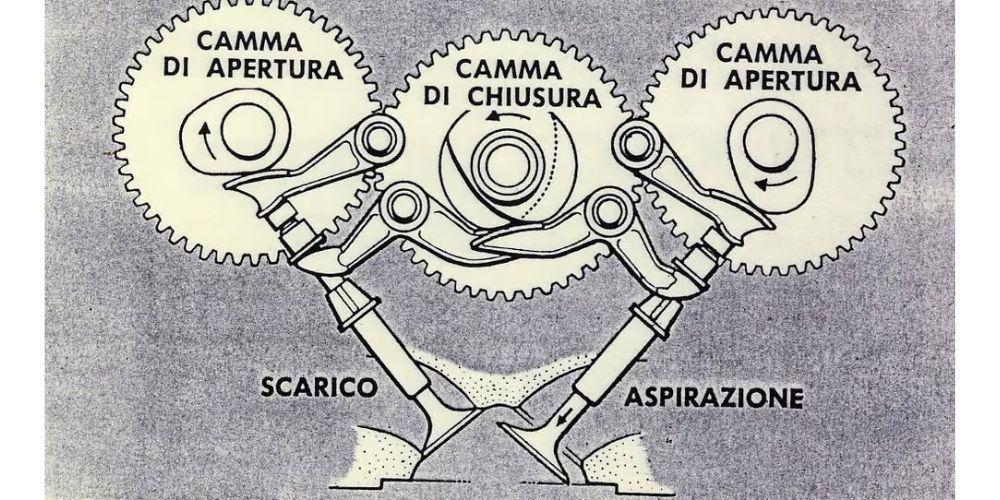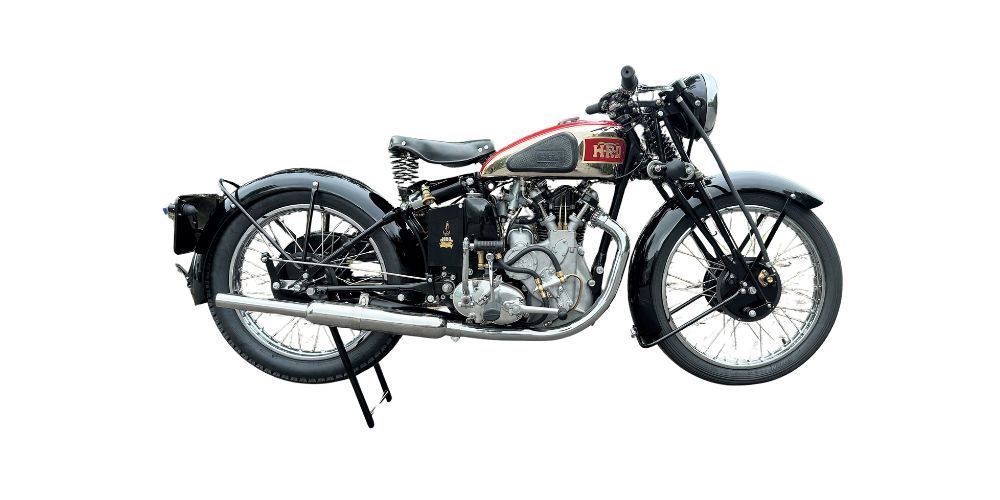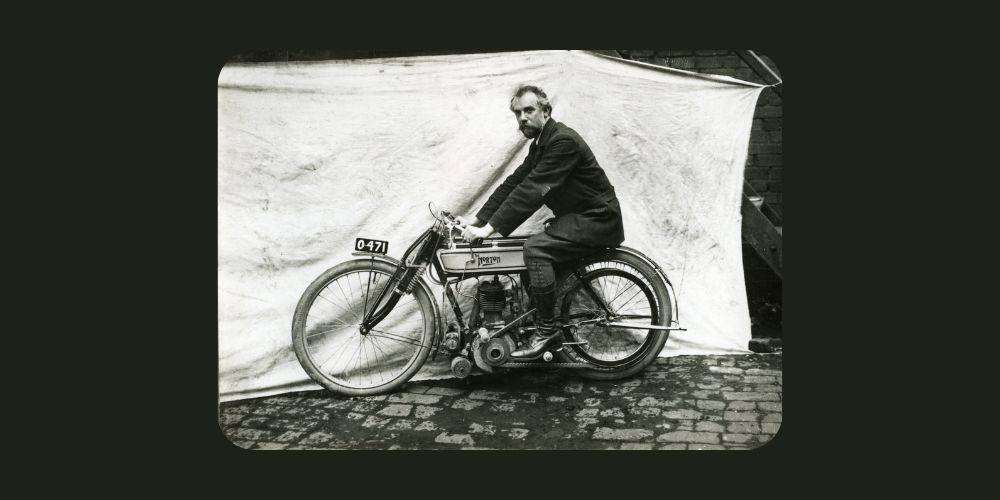German Motorcycle History: Exploring the Evolution of Iconic Bikes
German motorbikes, dating back to the early 1900s, remain pivotal in the story of motorcycles. Iconic manufacturers like NSU, DKW and BMW pioneered mass-production and innovative engine designs that propelled this narrative forward. Much akin to an unanticipated twist in a captivating tale, Nuremberg became a bastion of motorcycle production in the 1920s and 30s with companies such as Victoria, Hercules, Mars, and Triumph. This era brought forward trailblazing technology like the Zündapp Z 22 and remarkable racing triumphs that thrust German motorcycles into a globally admired spotlight. Diving deeper, let's explore where it all started.
The introduction of the Zündapp Z 22 in 1922 marked a significant milestone, helping establish mass motorization with its affordability and reliability. Additionally, the Triumph Knirps, launched in 1919, gained popularity with sports successes such as a victory in the 1923 Reichsfahrt race, showcasing the advancement of German motorcycle engineering and racing achievements.
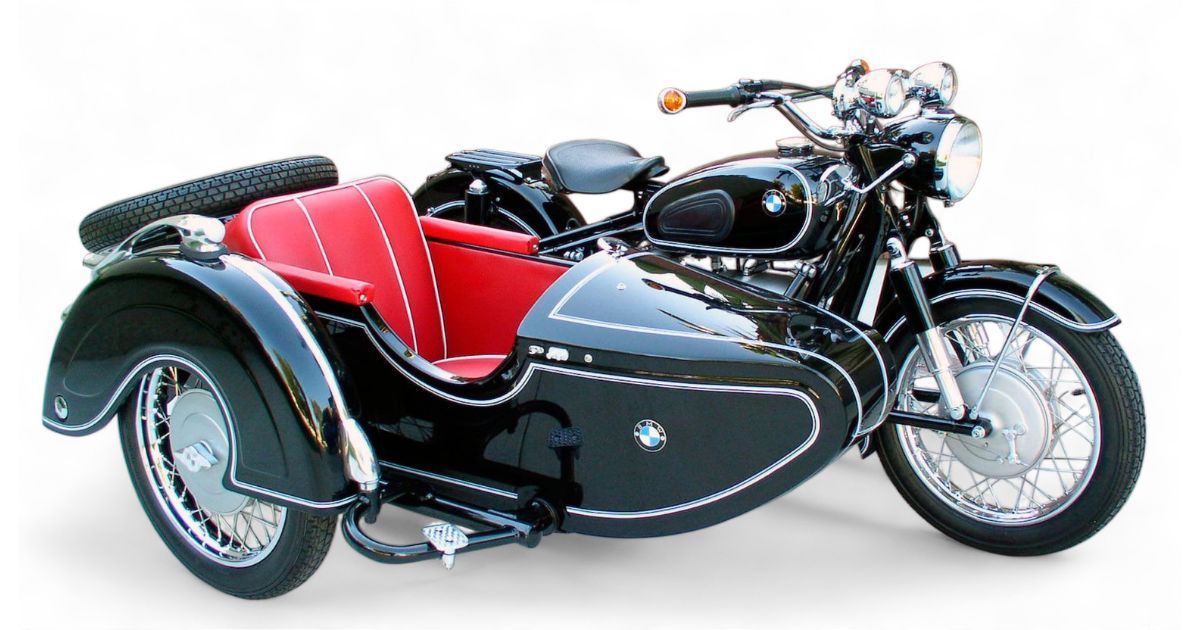
The Origins of German Motorcycle Industry
Germany's motorcycle heritage dates back to the late 19th century when skilled engineers and entrepreneurs laid the groundwork for an industry that left an indelible mark on the world. It was an era of great innovation and creativity, a melting pot of ideas culminating in the creation of pioneering motorcycles. This was a time when Germany was at the forefront of technological advancements across various industries.
In this fertile environment, brands like NSU Motorenwerke AG, DKW, and BMW emerged as trailblazers in early motorcycle manufacturing. Each of these companies significantly contributed to the development and progression of German engineering in the sector.
NSU Motorenwerke AG: Pioneers of Mass-Produced Motorcycles
NSU Motorenwerke AG holds the distinction of producing the first mass-produced motorcycle in 1901, marking a significant milestone in the industry. This achievement revolutionized motorcycle production, making motorcycles more accessible to a wider audience. The company's innovative approach and commitment to quality set a precedent for future manufacturers.
DKW: Innovators in Two-Stroke Engines
DKW, known for its innovative two-stroke engines, played a pivotal role in shaping the technological landscape of German motorcycles. The company's focus on engineering excellence and relentless pursuit of innovation positioned them as leaders in the field.
BMW: Shaping the Industry
BMW, a name synonymous with excellence, also made its mark on the early German motorcycle industry. The company's contributions were instrumental in shaping not only Germany's motorcycle landscape but also influencing global trends in motorcycle design and engineering.
By highlighting these pioneering efforts and showcasing the progression of German engineering in the sector, enthusiasts and novices alike can gain comprehensive knowledge about the foundations upon which the modern German motorcycle industry was built. Understanding this history offers valuable insights into the engineering prowess and innovation that continue to define German motorcycles today.
Unraveling these historical threads illuminates how each milestone and innovation played a crucial role in shaping the iconic German motorcycles we know today.
Pioneering Era: German Motorcycle Industry in 1920s-1930s
The 1920s and 1930s marked a transformative period for the German motorcycle industry. Nuremberg served as a vibrant hub of motorcycle manufacturing, hosting renowned companies like Victoria, Hercules, Mars, and Triumph. These pioneering firms laid the groundwork for an evolution that would not only revolutionize transportation but also captivate enthusiasts on a global scale.
During this time frame, German motorcycle manufacturers achieved significant strides in technological advancements. A notable milestone was the introduction of the Zündapp Z 22, launched in 1922. This model played a pivotal role in establishing mass motorization by offering affordability and reliability—a crucial step in making motorcycles more accessible to a wider population. The commitment to technological progress solidified Germany's position as a trailblazer in motorcycle engineering, sparking widespread interest in its innovative designs.
Moreover, the prowess of German motorcycles reached new heights through remarkable racing victories. For instance, Triumph Knirps' triumph in the arduous 1923 Reichsfahrt race showcased the exceptional performance and reliability of German motorcycles. This victory not only solidified Triumph's position as an industry leader but also served as a powerful testament to the capabilities of German engineering and craftsmanship.
"The 1920s and 1930s marked a significant period for the German motorcycle industry. Nuremberg, with companies like Victoria, Hercules, Mars, and Triumph, became a citadel of motorcycle manufacturing."
This period laid the foundation for what would become a golden age for German motorcycle production, setting unrivaled standards for performance, precision, and innovation. The competition between manufacturers fueled a fervent drive for excellence, resulting in unparalleled dedication to engineering and design.
Pioneering motorsports events further elevated the reputation of German motorcycles. The Franconian endurance races, popular during this era, not only captivated audiences but also served as compelling arenas for manufacturers to showcase their cutting-edge machines. These events became platforms for brands to demonstrate their motorcycles' durability, speed, and endurance—a marketing opportunity that significantly bolstered their prestige and public appeal.
In essence, the 1920s and 1930s were an era of meticulous craftsmanship, innovation, and competitive spirit. The accomplishments of this period not only transformed German motorcycle manufacturing but also positioned it as an indomitable force within the international motorcycle landscape.
The groundbreaking innovations of the past set the stage for a shift in focus as we delve into the Post-War Transformation: German Motorcycle Industry in 1940s-1950s - exploring how historical events shaped the trajectory of these iconic machines.
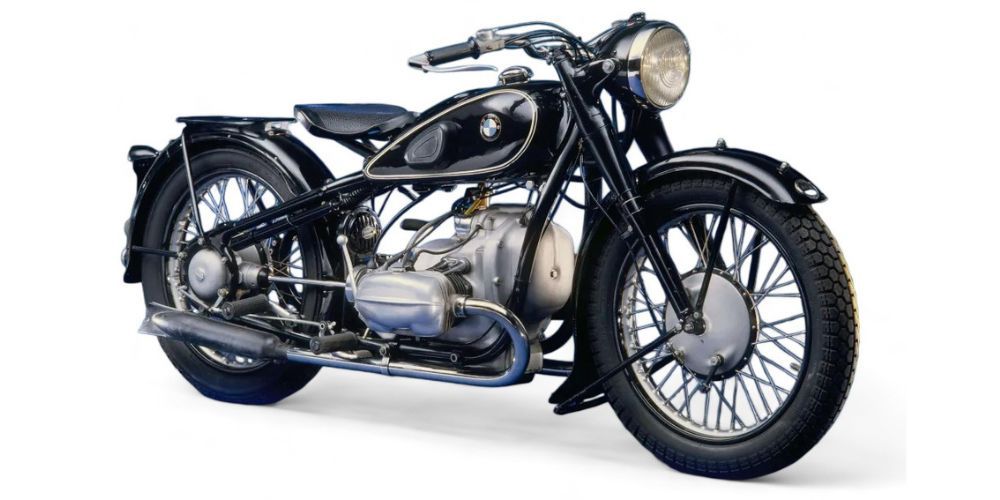
Post-War Transformation: German Motorcycles in 1940s-1950s
The aftermath of World War II brought about a period of recovery and rebuilding for the German motorcycle industry. Many manufacturers faced challenges due to war repercussions, including resource scarcities and economic instability. However, amidst these difficulties, there were notable instances of resilience and adaptability within the industry that reshaped its trajectory.
One such example is the resurgence of brands like Ardie and Victoria. These manufacturers not only managed to reestablish themselves but also gained attention through their distinctive designs and competitive racing successes. The post-war era demanded a shift in focus from wartime production to civilian-oriented motorcycles. This transition ignited a wave of innovation as manufacturers sought to adapt to the evolving needs of the market while integrating technological advancements born out of wartime developments.
At the heart of this transformation was the industry's ability to navigate adversities and emerge with innovative contributions. The resilience displayed by these manufacturers not only charted a new course for German motorcycle production but also showcased their capacity to thrive in challenging circumstances. Their adaptability served as a testament to the industry's enduring spirit, illustrating that even in times of great turbulence, innovation can flourish.
For instance, Ardie, known for its distinctive red machines, had garnered attention prior to the war through competitive racing with JAP engines from England. The Thumshirn brothers played a significant role in Ardie's success in races throughout Germany and Austria. In a similar vein, Victoria's KR 1 touring and sporting motorcycle made substantial contributions to Nuremberg's evolution as a citadel of motorcycling in the 1920s.
Furthermore, the post-war period witnessed an increased emphasis on mass motorization, with affordability and reliability becoming crucial factors. This led to the introduction of models such as Zündapp Z 22 in 1922, which played a pivotal role in establishing mass motorization with its accessibility and dependability. The evolving landscape post-war facilitated a shift towards more accessible and versatile motorcycles, reflecting the changing societal demands and economic conditions.
With these transformative shifts setting the stage for an era of innovation and adaptation, it becomes evident that the German motorcycle industry endured challenges while navigating a path towards reinvigoration and growth.
As we witness the remarkable metamorphosis of the German motorcycle industry in the post-war era, it paves the way for us to delve into the golden age—an era marked by unparalleled growth and ingenuity.
Golden Age: German Motorcycle Industry in 1960s-1970s
The 1960s and 1970s were pivotal decades for the German motorcycle industry, marking a period of substantial growth, innovation, and success. With iconic models like the BMW /5 series and technological advancements, this golden age was characterized by a fusion of engineering prowess and artistic design, setting new standards for performance and comfort in touring motorcycles.
Amidst this landscape of German motorcycle evolution, the BMW /5 series emerged as a shining example of engineering excellence. The series embodied the pinnacle of luxury and performance, featuring advanced telescopic front forks, a horizontally opposed air-cooled engine, and remarkable handling. This blend of cutting-edge technology and refined aesthetics set a new benchmark for touring motorcycles, making it a paragon of German craftsmanship.
In parallel with these developments, the arrival of the Honda CB750 Four sent shockwaves through the motorcycle world. Its innovative inline four-cylinder engine, electric starter, disc brakes, and exceptional reliability redefined expectations for performance motorcycles. This catalyzed a significant shift in motorcycle design and set new standards for power, efficiency, and rider comfort.
During this era, German manufacturers not only created high-performance machines but also earned acclaim for their emphasis on rider comfort. The ergonomic design philosophy prioritized rider well-being during long journeys without compromising on speed or agility. These motorcycles became synonymous with long-distance touring and unrivaled riding experiences.
Thus, the 1960s and 1970s witnessed an unparalleled convergence of technological innovation and artistic expression in Germany's motorcycle industry. The legacy of this remarkable period endures through the lasting impact these iconic models had on shaping the modern motorcycle landscape.
As we journey through time, let's now venture into the next phase where we witness the evolution of the German motorcycle industry from the late 20th century to the dawn of the new millennium.
- Over 90% of all motorcycles produced in Germany between 1920 and 1950 were exported to other countries.
- The BMW R75, a popular German motorcycle during World War II, had a top speed of 95 km/h.
- Out of the total number of motorcycles manufactured in Germany since the late 1800s, more than 30% were produced by BMW.
- Approximately 9 out of every 10 German motorcycles produced in the 1960s featured a two-stroke engine.
- The iconic Zündapp KS750, used extensively by the Wehrmacht during World War II, had a weight capacity of up to 500 kg.
Modern Revolution: German Motorcycle Industry in 1980s-2000s
The 1980s marked a turning point for the German motorcycle industry as technological advancements and innovative designs took center stage. This period saw a significant emphasis on incorporating cutting-edge technologies, elevating the standards for motorcycle performance, safety, and comfort. Brands like BMW and KTM led the charge by introducing state-of-the-art features such as electronically controlled suspension systems, advanced engine management systems, and aerodynamic enhancements.
This era of transformation was driven by a relentless commitment to pioneering innovation. Manufacturers dedicated themselves to refining not just the external appearance of motorcycles but also their internal mechanisms and riding experiences. The development of electronic control systems heralded a new age in motorcycle engineering, providing riders with enhanced stability, control, and safety.
BMW emerged as a trailblazer during this time with their innovative use of computer-controlled suspension technologies. This advancement allowed for real-time adjustments to the suspension system based on varying road conditions, thereby significantly improving riding comfort and overall safety. Furthermore, advancements in engine management systems led to more efficient fuel consumption and reduced emissions, aligning with the growing emphasis on environmental sustainability.
Similarly, KTM sought to redefine motorcycle aerodynamics by leveraging modern design principles and wind tunnel testing to optimize performance and handling. This commitment to aerodynamic enhancements not only enhanced the overall riding experience but also aligned with evolving consumer preferences for speed and agility.
The evolution of the German motorcycle industry during this period spoke volumes about its dedication to pushing boundaries and redefining conventional standards. These dynamic changes set a new benchmark for motorcycle technology, underscoring Germany's position as a formidable force in the global motorcycle arena.
Exemplifying Germany's prowess in motorcycle technology and engineering during this period, these innovations set the stage for even greater strides in the industry's evolution.
German Motorcycle Technology and Engineering
When discussing German motorcycle technology and engineering, it's not just about the technical specs and design details, but a commitment to pushing the boundaries of what's possible, setting new standards, and redefining the entire concept of motorcycle craftsmanship.
Precision Engineering and Innovation
German motorcycle manufacturers have consistently showcased their unwavering dedication to precision engineering and innovation. Each component, from the engine to the braking system, is meticulously designed and tested to ensure optimal performance and safety. This emphasis on precision distinguishes German motorcycles - there's an almost obsessive attention to detail that guarantees a level of quality that is truly unrivaled.
Germany's engineering prowess extends beyond motorcycles into many other industries, placing a significant emphasis on high-quality manufacturing and innovative solutions.
Advanced Technological Features
The implementation of cutting-edge features such as anti-lock braking systems (ABS), traction control, electronic rider aids, and advanced suspension systems has been a hallmark of German motorcycle engineering. These features not only enhance safety but also elevate the overall riding experience, showcasing the industry's commitment to rider safety, particularly when navigating challenging road conditions.
For instance, the introduction of dynamic damping control systems has revolutionized suspension technology, providing riders with a smoother and more controlled ride. This innovative approach to technological integration has cemented German motorcycles as leaders in both performance and safety.
Dedication to Safety
German motorcycle manufacturers place a significant emphasis on rider safety, evident in their continuous pursuit of cutting-edge safety technologies. For example, the development of adaptive headlight systems that adjust based on road conditions and rider behavior is just one example of how these manufacturers focus on enhancing rider safety.
These technological innovations are not just about pushing the limits; they're about ensuring that riders feel confident and secure on the road.
The precision engineering, advanced technological features, and unwavering dedication to safety form the bedrock of German motorcycle technology and engineering, establishing a legacy of quality and innovation that resonates throughout the industry.
In understanding the influence of German motorcycle craftsmanship globally, a deeper appreciation for its impact on the international stage becomes evident.
Impact of German Motorcycles on Global Stage
German motorcycles have made a significant mark in racing events worldwide, earning a reputation for exceptional agility, speed, and precision. Racing victories not only showcased the capabilities and performance of these iconic bikes but also propelled them into popular culture as symbols of excellence and innovation. The historic achievements on racetracks around the world demonstrated the quality, reliability, and high standards set by German motorcycle manufacturers.
Moreover, the influence of German motorcycle engineering has transcended the boundaries of the motorcycle industry and extended its reach into other domains. The technologies developed through German motorcycle innovation have found applications in high-performance cars, revolutionizing the automotive sector with cutting-edge advancements that originated from the world of two-wheeled machines.
In addition to racing triumphs and technological advancements, the influence of German motorcycles has left an indelible mark on design trends across industries. The aesthetic appeal and functional designs of German motorcycles have permeated popular culture, influencing not only motorcycle enthusiasts but also shaping broader design trends in areas such as automotive design, fashion, and industrial aesthetics.
Take, for example, how the sleek lines and aerodynamic principles embraced by German motorcycle manufacturers have inspired designers in various industries. The attention to detail in every aspect of design, from ergonomics to performance-driven features, has established a standard that continues to be emulated and admired worldwide.
The legacy of German motorcycles is not just confined to their own industry; it has rippled through time and across borders, influencing technological standards and inspiring innovation in diverse sectors. By setting benchmarks in terms of durability, performance, and precision engineering, German motorcycles have played a pivotal role in shaping industry standards across various domains.
As we reflect on the multifaceted impact of German motorcycles on the global stage—from racing dominance to cross-industry influence—it becomes evident that their legacy is not just confined to highways or racetracks but resonates across a wide spectrum of human endeavors.
The enduring impact of German motorcycles is a testament to their extraordinary legacy, which continues to influence multiple industries and inspire innovations worldwide. Their story is one of resilience, excellence, and relentless pursuit of engineering perfection.
- German motorcycle industry began in the late 19th century with pioneers like Werner Brothers and Hildebrand & Wolfmüller.
- BMW, one of the most famous German motorcycle manufacturers, started producing motorcycles in 1923.
- The iconic brand, Harley-Davidson, was founded by William S. Harley and Arthur Davidson, both of which had German heritage.
- During World War II, many German motorcycle manufacturers shifted their production to military motorcycles.
- The legendary brand, MZ (Motorradwerk Zschopau), produced popular motorcycles from the 1950s until the 1990s before ceasing operations.
Which German motorcycle brand is the oldest?
DKW (Dampf-Kraft-Wagen) is the oldest German motorcycle brand, founded in 1916.
When did Zündapp start manufacturing motorcycles?
Zündapp (Zünd-Apparatebau-Gesellschaft mbH) started manufacturing motorcycles in 1921. They became known for their reliable and innovative designs.
Did NSU originally produce motorcycles?
Yes, NSU (Neckarsulm Strickmaschinenfabrik) began as a knitting machine manufacturer but started producing motorcycles in 1901. They later shifted focus to automobiles and merged with Auto Union in 1969.
What is the significance of the Adler brand in German motorcycle history?
Adler, founded in 1900, initially produced bicycles and typewriters but began motorcycle production in 1902. They were known for their innovative designs and competitive racing motorcycles.
When did Horex start producing motorcycles, and what were they known for?
Horex was founded in 1923 and began producing motorcycles in 1924. They were known for their high-quality, technically advanced machines and achieved success in racing.
What happened to DKW after World War II?
Following World War II, DKW became part of Auto Union, which later evolved into Audi. Motorcycle production under the DKW brand ceased in the 1960s.
About the Author
William Flaiz, passionate about European motorcycle brands, shares his expertise and stories on RunMotorun.com. He offers detailed insights and reviews, aiming to educate both seasoned enthusiasts and newcomers. Flaiz combines personal experience with thorough research, welcoming visitors to explore the rich world of European motorcycles alongside him.


